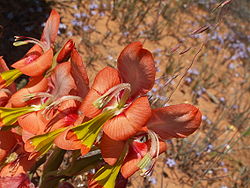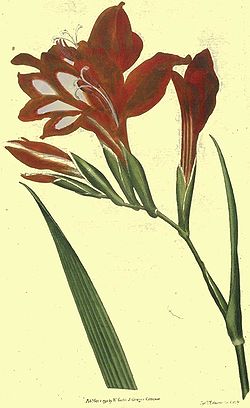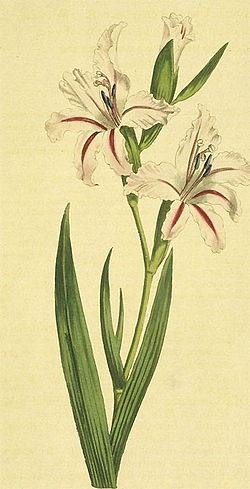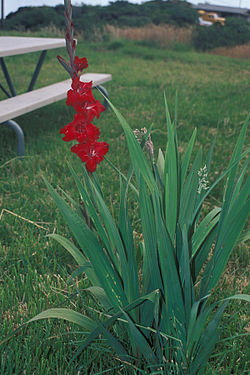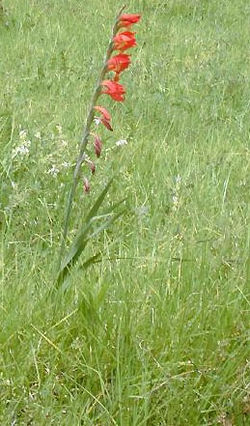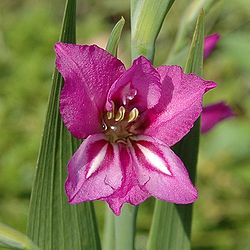- Gladiolus
-
For other uses, see Gladiolus (disambiguation).
Gladiolus Gladiolus Scientific classification Kingdom: Plantae (unranked): Angiosperms (unranked): Monocots Order: Asparagales Family: Iridaceae Subfamily: Ixioideae Tribe: Ixieae Genus: Gladiolus
L.Type species Gladiolus communis
L.Species About 260, see text
Gladiolus (from Latin, the diminutive of gladius, a sword) is a genus of perennial bulbous flowering plants in the iris family (Iridaceae).[1] Sometimes called the sword lily, the most widely used English common name for these plants is simply gladiolus (plural gladioli, gladioluses or sometimes gladiolas).
The genus is distributed in Mediterranean Europe, Asia, Tropical Africa and South Africa. The center of diversity of the genus is located in the Cape Floristic Region, where most species were discovered.[2] The genera Oenostachys, Homoglossum, Anomalesia and Acidanthera, traditionally considered independent entities, currently are included in Gladiolus.[3]
Contents
Description
The genus Gladiolus contains about 260 species, of which 250 are native to sub-Saharan Africa, mostly South Africa. About 10 species are native to Eurasia. There are 160 species of Gladiolus endemic in southern Africa and 76 in tropical Africa. The flowers of unmodified wild species vary from very small to perhaps 40 mm across, and inflorescences bearing anything from one to several flowers. The spectacular giant flower spikes in commerce are the products of centuries of hybridisation, selection, and perhaps more drastic manipulation.
These attractive, perennial herbs are semihardy in temperate climates. They grow from rounded, symmetrical corms, that are enveloped in several layers of brownish, fibrous tunics.
Their stems are generally unbranched, producing 1 to 9 narrow, sword-shaped, longitudinal grooved leaves, enclosed in a sheath. The lowest leaf is shortened to a cataphyll. The leaf blades can be plane or cruciform in cross section.
The fragrant flower spikes are large and one-sided, with secund, bisexual flowers, each subtended by 2 leathery, green bracts. The sepals and the petals are almost identical in appearance, and are termed tepals. They are united at their base into a tube-shaped structure. The dorsal tepal is the largest, arching over the three stamens. The outer three tepals are narrower. The perianth is funnel-shaped, with the stamens attached to its base. The style has three filiform, spoon-shaped branches, each expanding towards the apex.
The ovary is 3-locular with oblong or globose capsules, containing many, winged brown, longitudinally dehiscent seeds. In their center must be noticeable the specific pellet like structure which is the real seed without the fine coat. In some seeds this structure is wrinkled and with black color. These seeds are unable to germinate.
These flowers are variously colored, pink to reddish or light purple with white, contrasting markings, or white to cream or orange to red.
The South African species were originally pollinated by long-tongued anthrophorine bees, but some changes in the pollination system have occurred, allowing pollination by sunbirds, noctuid and sphingid moths, long-tongued flies and several others. In the temperate zones of Europe many of the hybrid large flowering sorts of gladiolas can be pollinated by small well-known wasps. Actually, They are not very good pollinators because of the large flowers of the plants and the small size of the wasps. Another insect in this zone which can try some of the nectar of the gladioli is the best-known European Hawk-moth Macroglossum stellatarum which usually pollinates many popular garden flowers like Petunia, Zinnia, Dianthus and others.
Gladioli are used as food plants by the larvae of some Lepidoptera species including the Large Yellow Underwing.
Gladioli have been extensively hybridized and a wide range of ornamental flower colours are available from the many varieties. The main hybrid groups have been obtained by crossing between four or five species, followed by selection: Grandiflorus, Primulines and Nanus. They make very good cut flowers. However, due to their height, the cultivated forms frequently tend to fall over in the wind if left on the plant.
The majority of the species in this genus are diploids with 30 chromosomes but the Grandiflora hybrids are tetraploids and possess 60 chromosomes. It's because the main parental species of these hybrids is Gladiolus dalenii which is also tetraploid and includes a wide range of varieties (like the Grandiflora hybrids).
Species
The genus Gladiolus has been divided in to many sections. Where possible, the sections have been indicated. Most species, however, are only tentatively placed.
- Gladiolus abbreviatus Andrews
- Gladiolus acuminatus F.Bol.
- Gladiolus aequinoctialis Herb.
- Gladiolus alatus L. (sect. Hebea)
- Gladiolus aleppicus Boiss. var. aleppicus
- Gladiolus anatolicus
- Gladiolus andringitrae Goldblatt
- Gladiolus angustus L. (sect. Blandus) : Long-tubed Painted Lady
- Gladiolus antandroyi Goldblatt
- Gladiolus antholyzoides Baker
- Gladiolus appendiculatus G.Lewis
- Gladiolus aquamontanus Goldblatt & Vlok
- Gladiolus arcuatus Klatt
- Gladiolus atropurpureus Baker
- Gladiolus atroviolaceus Boiss.
- Gladiolus aurantiacus Klatt
- Gladiolus aureus Baker : Golden Gladiolus
- Gladiolus bellus C. H. Wright
- Gladiolus benguellensis Baker (sect. Ophiolyza)
- Gladiolus bilineatus G. J. Lewis
- Gladiolus boehmii Vaupel (1882)
- Gladiolus bojeri (Baker) Goldblatt
- Gladiolus brachylimbus Baker (1893)
- Gladiolus brachyphyllus F. Bolus or Bolus f.
- Gladiolus brevifolius Jacq. (sect. Linearifolius)
- Gladiolus brevitubus G. Lewis
- Gladiolus buckerveldii (L. Bolus) Goldblatt
- Gladiolus bullatus Thunb. ex G. Lewis : Caledon Bluebell
- Gladiolus caeruleus Goldblatt & J.C. Manning
- Gladiolus calcaratus G. Lewis
- Gladiolus calcicola Goldblatt
- Gladiolus callianthus Mosais : Abyssinian Gladiolus
- Gladiolus canaliculatus Goldblatt
- Gladiolus candidus (Rendle) Goldblatt
- Gladiolus cardinalis Curtis (sect. Blandus)
- Gladiolus carinatus Aiton
- Gladiolus carmineus C. H. Wright (sect. Blandus) : Cliff Lily
- Gladiolus carneus (sect. Blandus) : Large Painted Lady
- Gladiolus caryophyllaceus (Burm. f.) Poiret
- Gladiolus cataractarum Oberm.
- Gladiolus caucasicus Herb.
- Gladiolus ceresianus L. Bolus
- Gladiolus citrinus Klatt
- Gladiolus x colvillei : Colville's Gladiolus
- Gladiolus communis L. (sect. Gladiolus) : Cornflag (type species)
- Gladiolus communis subsp. byzantinus (sect. Gladiolus) - Whistling Jack, Eastern Gladiolus
- Gladiolus communis subsp. communis (sect. Gladiolus)
- Gladiolus conrathii Baker (1898)
- Gladiolus crassifolius Baker
- Gladiolus crispulatus L. Bolus
- Gladiolus cruentus T. Moore (sect. Ophiolyza)
- Gladiolus curtifolius Marais
- Gladiolus cuspidatus
- Gladiolus cylindraceus G. Lewis
- Gladiolus cymbarius Baker
- Gladiolus dalenii Van Geel (sect. Ophiolyza)
- Gladiolus debilis Ker Gawler (sect. Homoglossum) : Small Painted Lady
- Gladiolus decaryi Goldblatt
- Gladiolus decipiens Vaupel
- Gladiolus decoratus Baker
- Gladiolus delpierrei Goldblatt
- Gladiolus densiflorus Baker
- Gladiolus deserticolus Goldblatt
- Gladiolus dolomiticus Oberm.
- Gladiolus dracocephalus Hook.f.
- Gladiolus dregei Klatt
- Gladiolus dubius
- Gladiolus dzavakheticus
- Gladiolus ecklonii Lehm.
- Gladiolus edulis Burchell ex Ker Gawler
- Gladiolus elliotii Baker (sect. Ophiolyza)
- Gladiolus emiliae L. Bolus
- Gladiolus engysiphon G. Lewis
- Gladiolus equitans Thunb. (sect. Hebea)
- Gladiolus erectiflorus Baker
- Gladiolus exiguus G. Lewis
- Gladiolus flanaganii Baker : : Suicide Gladiolus
- Gladiolus floribundus Jacq.
- Gladiolus fourcadei (L. Bolus) Goldblatt & De Vos
- Gladiolus ×gandavensis (sect. Ophiolyza) [= G. dalenii × 'G. oppositiflorus]
- Gladiolus garnierii Klatt
- Gladiolus geardii L. Bolus
- Gladiolus goetzii Harms
- Gladiolus gracilis Jacq. (sect. Homoglossum) : Reed Bells
- Gladiolus gracillimus Baker
- Gladiolus grandiflorus (sect. Blandus)
- Gladiolus gregarius Welw. ex Baker (sect. Densiflorus)
- Gladiolus griseus Goldblatt & J.C. Manning
- Gladiolus gueinzii Kunze
- Gladiolus guthriei F. Bol. (sect. Linearifolius)
- Gladiolus halophilus Boiss. & Heldr.
- Gladiolus harmsianus Vaupel
- Gladiolus heterolobus Vaupel
- Gladiolus hirsutus Jacq. (sect. Linearifolius) : Small Pink Afrikaner
- Gladiolus hollandii L. Bolus
- Gladiolus horombensis Goldblatt
- Gladiolus huillensis (Welw. ex Baker) Goldblatt
- Gladiolus hyalinus Jacq.
- Gladiolus illyricus W.D.J.Koch - Wild Gladiolus
- Gladiolus imbricatus L.
- Gladiolus inandensis Baker
- Gladiolus incospicuus Baker
- Gladiolus inflatus Thunb.
- Gladiolus inflexus Goldblatt & J.C. Manning
- Gladiolus insolens Goldblatt & J.C. Manning
- Gladiolus intonsus Goldblatt
- Gladiolus invenustus G. J. Lewis
- Gladiolus involutus (sect. Hebea)
- Gladiolus iroensis (A. Chev.) Marais
- Gladiolus italicus P. Mill. (sect. Gladiolus) - Italian Gladiolus, Cornflag
- Gladiolus johnstoni Baker (s. d.)
- Gladiolus jonquilliodorus Ecklon ex G. Lewis
- Gladiolus junodi Baker
- Gladiolus kamiesbergensis G. Lewis
- Gladiolus karendensis Baker
- Gladiolus katubensis De Wild.
- Gladiolus klattianus Hutch.
- Gladiolus kotschyanus Boiss.
- Gladiolus kubangensis Harms
- Gladiolus lapeirousioides Goldblatt
- Gladiolus laxiflorus Baker
- Gladiolus lemoinei
- Gladiolus leptosiphon Bolus f.
- Gladiolus liliaceus Houtt. (sect. Homoglossum)
- Gladiolus linearifolius Vaupel
- Gladiolus linearis N.E.Br.
- Gladiolus longanus Harms
- Gladiolus longicollis Baker (sect. Homoglossum)
- Gladiolus longicollis subsp. longicollis (sect. Homoglossum)
- Gladiolus longicollis subsp. platypetalus (sect. Homoglossum)
- Gladiolus loteniensis Hilliard & Burtt
- Gladiolus louiseae L. Bolus
- Gladiolus lundaensis Goldblatt
- Gladiolus luteus Lam.
- Gladiolus lyalinus
- Gladiolus macneilii Oberm.
- Gladiolus macowani Baker
- Gladiolus macowanii Baker (s. d.)
- Gladiolus macrospathus Goldblatt
- Gladiolus maculatus Sweet
- Gladiolus magnificus (Harms) Goldblatt
- Gladiolus malangensis Baker (1879)
- Gladiolus malvinus Goldblatt & J.C. Manning
- Gladiolus marlothii G. Lewis
- Gladiolus martleyi L. Bolus (sect. Homoglossum)
- Gladiolus meliusculus (G. Lewis) Goldblatt & J.C. Manning
- Gladiolus melleri Baker (sect. Ophiolyza)
- Gladiolus micranthus Baker (1901)
- Gladiolus microcarpus G. Lewis
- Gladiolus microsiphon Baker
- Gladiolus milleri Ker Gawler
- Gladiolus mirus Vaupel
- Gladiolus monticola G. Lewis ex Goldblatt & J.C. Manning
- Gladiolus mortonius (sect. Densiflorus)
- Gladiolus mostertiae L. Bolus
- Gladiolus muenzneri F. Vaup
- Gladiolus murielae (sect. Acidanthera)
- Gladiolus natalensis (Eckl.) Hook.
- Gladiolus nerineoides G. Lewis
- Gladiolus newii Baker
- Gladiolus nigromontanus Goldblatt
- Gladiolus niveus Goldblatt & J.C. Manning
- Gladiolus nyasicus Goldblatt
- Gladiolus oatesii Rolfe
- Gladiolus ochroleucus Baker (sect. Densiflorus)
- Gladiolus odoratus L. Bolus
- Gladiolus oliganthus Baker
- Gladiolus oppositiflorus Herbert (sect. Ophiolyza)
- Gladiolus orchidiflorus Andrews (sect. Hebea)
- Gladiolus oreocharis Schltr.
- Gladiolus pallidus Baker
- Gladiolus paludosus Baker
- Gladiolus palustris : Marsh Gladiolus
- Gladiolus papilio Hook. f. (sect. Densiflorus) : Goldblotch Gladiolus
- Gladiolus pappei Baker (sect. Blandus)
- Gladiolus pardalinus Goldblatt & J.C. Manning
- Gladiolus parvulus Schltr.
- Gladiolus patersoniae F. Bolus or Bolus f.
- Gladiolus pavonia Goldblatt & J.C. Manning
- Gladiolus permeabilis Delaroche (sect. Hebea)
- Gladiolus perrieri Goldblatt
- Gladiolus persicus Boiss.
- Gladiolus pillansii G. Lewis
- Gladiolus pole-evansii Verd.
- Gladiolus praecostatus
- Gladiolus praelongitubus G. J. Lewis
- Gladiolus pretoriensis Kuntze
- Gladiolus priorii (N. E. Br.) Goldblatt & De Vos
- Gladiolus prismatosiphon Schltr.
- Gladiolus pritzelii Diels
- Gladiolus psittacinus Hook.
- Gladiolus puberulus Vaupel
- Gladiolus pubigerus G. Lewis
- Gladiolus pulchellus Klatt
- Gladiolus pulcherrimus (G. Lewis) Goldblatt & J.C. Manning
- Gladiolus punctulatus Schrank
- Gladiolus pusillus Goldblatt
- Gladiolus quadrangularis (Burm. f.) Ker Gawler
- Gladiolus quadrangulus (Delaroche) Barnard
- Gladiolus ramosus
- Gladiolus recurvus (sect. Homoglossum)
- Gladiolus rehmannii Baker
- Gladiolus remotifolius Baker
- Gladiolus rigidifolius Baker
- Gladiolus robertsoniae F. Bolus or Bolus f.
- Gladiolus rogersii Baker
- Gladiolus roseovenosus Goldblatt & J.C. Manning
- Gladiolus rubellus Goldblatt
- Gladiolus rudis Lichtst. ex Roem. & Schult.
- Gladiolus rupicola F. Vaupel
- Gladiolus saccatus (Klatt) Goldblatt & M.P. de Vos
- Gladiolus salteri G. Lewis
- Gladiolus saundersii Hook. f. : Saunders' Gladiolus, Lesotho Lily
- Gladiolus schlechteri Baker
- Gladiolus schweinfurthii Baker
- Gladiolus scullyi Baker
- Gladiolus serapiiflorus Goldblatt
- Gladiolus serenjensis Goldblatt
- Gladiolus sericeovillosus Hook. f.
- Gladiolus serpenticola Goldblatt & J.C. Manning
- Gladiolus somalensis Goldblatt & Thulin
- Gladiolus speciosus Thunb.
- Gladiolus spectabilis Baker (s. d.)
- Gladiolus splendens ((Sweet)) Herbert
- Gladiolus stefaniae Oberm.
- Gladiolus stellatus G. Lewis
- Gladiolus subcaeruleus G. Lewis
- Gladiolus sufflavus (G. Lewis) Goldblatt & J.C. Manning
- Gladiolus sulcatus Goldblatt
- Gladiolus taubertianus Schltr.
- Gladiolus tenellus Ecklon
- Gladiolus tenuis M. Bieb.
- Gladiolus teretifolius Goldblatt & De Vos
- Gladiolus thomsonii Baker
- Gladiolus trichonemifolius (sect. Homoglossum)
- Gladiolus tristis (sect. Homoglossum)
- Gladiolus tristis var. concolor (Salisb.) Baker : Ever-flowering Gladiolus
- Gladiolus tritoniaeformis
- Gladiolus tritoniiformis Kuntze
- Gladiolus uitenhagensis Goldblatt & Vlok
- Gladiolus undulatus L. (sect. Blandus) : Waved-flowered Gladiolus
- Gladiolus unguiculatus Baker
- Gladiolus usambarensis Marais ex Goldblatt
- Gladiolus uysiae L. Bolus ex G. Lewis
- Gladiolus vaginatus F. Bolus or Bolus f. (sect. Homoglossum)
- Gladiolus validissimus Vaupel
- Gladiolus vandermerwei (L. Bolus) Goldblatt & De Vos
- Gladiolus varius F. Bolus or Bolus f.
- Gladiolus velutinus De Wild.
- Gladiolus venustus G. Lewis (sect. Hebea)
- Gladiolus vernus Oberm.
- Gladiolus vinoso-maculatus Kies
- Gladiolus violaceo-lineatus G. Lewis
- Gladiolus virescens Thunb. (sect. Hebea)
- Gladiolus viridiflorus G. Lewis
- Gladiolus viridis Aiton
- Gladiolus watermeyeri (sect. Hebea)
- Gladiolus watsonioides Baker
- Gladiolus watsonius Thunb. (sect. Homoglossum)
- Gladiolus woodii Baker
- Gladiolus zimbabweensis Goldblatt
Cultivation
In temperate zones, the corms of most species and hybrids should be lifted in autumn and stored over winter in a frost-free place, then replanted in spring. Some species from Europe and high altitudes in Africa, as well as the small 'Nanus' hybrids, are much hardier (to at least -15°F/-26°C) and can be left in the ground in regions with sufficiently dry winters. Plants are propagated either from small cormlets produced as offsets by the parent corms, or from seed; in either case, they take several years to get to flowering size. Clumps should be dug up and divided every few years to keep them vigorous.
A popular 'Nanus' cultivar is Atom.
In culture
- The Mancunian singer Morrissey is known to dance with gladioli, hanging from his back pocket or in his hands, especially during the era of The Smiths.[4]This trait of his was made known in the music video for This Charming Man, where he swung a bunch of yellow[5]gladioli while singing.
- The Austrailian cross-dressing comedian Dame Edna Everage's signature flower is the gladioli.[6]
References
- ^ Manning, John; Goldblatt, Peter (2008). The Iris Family: Natural History & Classification. Portland, Oregon: Timber Press. pp. 138–42. ISBN 0-88192-897-6.
- ^ Goldblatt, P. &, J.C. Manning. Gladiolus in Southern Africa : Systematics, Biology, and Evolution. Fernwood Press, Cape Town; 1998.
- ^ GOLDBLATT P. & DE VOS M. P. The reduction of Oenostachys, Homoglossum and Anomalesia, putative sunbird pollinated genera, in Gladiolus L. (Iridaceae-Ixioideae). Bulletin du Muséum national d'histoire naturelle. Section B, Adansonia 11 (4): 417-428, 1989.
- ^ Rainy-day voice of a generation
- ^ This Charming Man
- ^ Dame Edna Everage and gladioli
External links
Bibliography
- G R Delpierre and N M du Plessis (1974) - The winter-growing Gladioli of Southern Africa. 120 colour photographs and descriptions; (Tafelberg-Uitgewers Beperk)
- Peter Goldblatt (1996)- A monograph of the genus Gladiolus in tropical Africa (83 species) (Timber Press)
- Peter Goldblatt, J.C. Manning (1998)- Gladiolus in southern Africa : Systematics, Biology, and Evolution, including 144 watercolor paintings; (Fernwood Press, Cape Town)
Categories:- Gladiolus
- Iridaceae genera
- Garden plants
- Latin words and phrases
- Plants and pollinators
Wikimedia Foundation. 2010.


